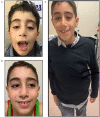Case Report: A Novel AChR Epsilon Variant Causing a Clinically Discordant Salbutamol Responsive Congenital Myasthenic Syndrome in Two Egyptian Siblings
- PMID: 35720108
- PMCID: PMC9201482
- DOI: 10.3389/fneur.2022.909715
Case Report: A Novel AChR Epsilon Variant Causing a Clinically Discordant Salbutamol Responsive Congenital Myasthenic Syndrome in Two Egyptian Siblings
Abstract
Congenital myasthenic syndromes (CMS) are inherited disorders that lead to abnormal neuromuscular transmission. Post-synaptic mutations are the main cause of CMS, particularly mutations in CHRNE. We report a novel homozygous CHRNE pathogenic variant in two Egyptian siblings showing a CMS. Interestingly, they showed different degrees of extraocular and skeletal muscle involvement; both presented only a partial response to cholinesterase inhibitors, and rapidly and substantially ameliorated after the addition of oral β2 adrenergic agonists. Here, we enlarge the genetic spectrum of CHRNE-related congenital myasthenic syndromes and highlight the importance of a β2 adrenergic agonists treatment.
Keywords: CHRNE; congenital myasthenic syndrome; neuromuscular junction; salbutamol; β2 adrenergic agonists.
Copyright © 2022 Gómez-García de la Banda, Simental-Aldaba, Fahmy, Sternberg, Blondy, Quijano-Roy and Malfatti.
Conflict of interest statement
The authors declare that the research was conducted in the absence of any commercial or financial relationships that could be construed as a potential conflict of interest.
Figures



Similar articles
-
A Novel Homozygous Variant in the CHRNE Gene in 2 Siblings with Congenital Myasthenic Syndrome.Child Neurol Open. 2023 Nov 28;10:2329048X231216432. doi: 10.1177/2329048X231216432. eCollection 2023 Jan-Dec. Child Neurol Open. 2023. PMID: 38034490 Free PMC article.
-
Pharmacological Strategy for Congenital Myasthenic Syndrome with CHRNE Mutations: A Meta-Analysis of Case Reports.Curr Neuropharmacol. 2021;19(5):718-729. doi: 10.2174/1570159X18666200729092332. Curr Neuropharmacol. 2021. PMID: 32727330 Free PMC article.
-
β2-Adrenergic receptor agonists ameliorate the adverse effect of long-term pyridostigmine on neuromuscular junction structure.Brain. 2019 Dec 1;142(12):3713-3727. doi: 10.1093/brain/awz322. Brain. 2019. PMID: 31633155 Free PMC article.
-
[Congenital myasthenic syndromes: phenotypic expression and pathophysiological characterisation].Rev Neurol (Paris). 2004 Feb;160(2):163-76. doi: 10.1016/s0035-3787(04)70887-5. Rev Neurol (Paris). 2004. PMID: 15034473 Review. French.
-
[Congenital myasthenic syndromes: difficulties in the diagnosis, course and prognosis, and therapy--The French National Congenital Myasthenic Syndrome Network experience].Rev Neurol (Paris). 2013 Feb;169 Suppl 1:S45-55. doi: 10.1016/S0035-3787(13)70060-2. Rev Neurol (Paris). 2013. PMID: 23452772 Review. French.
References
-
- Abicht A, Dusl M, Gallenmüller C, Guergueltcheva V, Schara U, Della Marina A, et al. . Congenital myasthenic syndromes: achievements and limitations of phenotype-guided gene-after-gene sequencing in diagnostic practice: a study of 680 patients. Hum Mutat. (2012) 33:1474–84. 10.1002/humu.22130 - DOI - PubMed
Publication types
LinkOut - more resources
Full Text Sources

